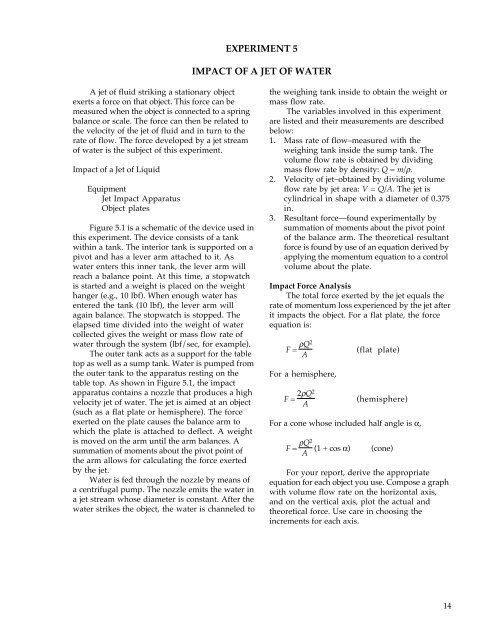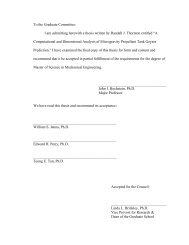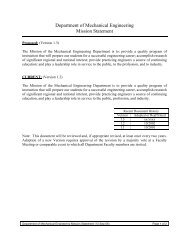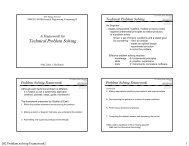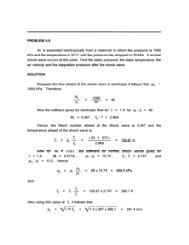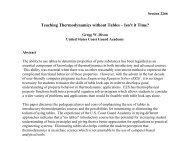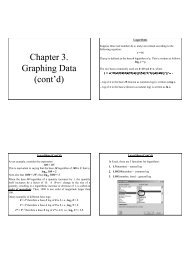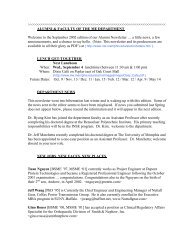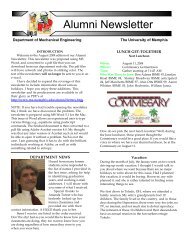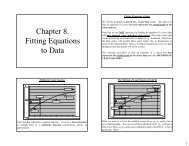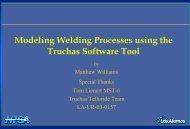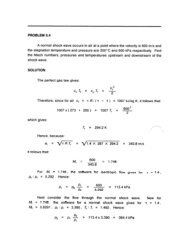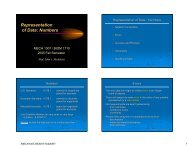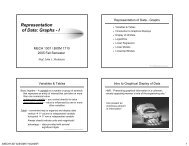MECHANICS of FLUIDS LABORATORY - Mechanical Engineering
MECHANICS of FLUIDS LABORATORY - Mechanical Engineering
MECHANICS of FLUIDS LABORATORY - Mechanical Engineering
You also want an ePaper? Increase the reach of your titles
YUMPU automatically turns print PDFs into web optimized ePapers that Google loves.
EXPERIMENT 5<br />
IMPACT OF A JET OF WATER<br />
A jet <strong>of</strong> fluid striking a stationary object<br />
exerts a force on that object. This force can be<br />
measured when the object is connected to a spring<br />
balance or scale. The force can then be related to<br />
the velocity <strong>of</strong> the jet <strong>of</strong> fluid and in turn to the<br />
rate <strong>of</strong> flow. The force developed by a jet stream<br />
<strong>of</strong> water is the subject <strong>of</strong> this experiment.<br />
Impact <strong>of</strong> a Jet <strong>of</strong> Liquid<br />
Equipment<br />
Jet Impact Apparatus<br />
Object plates<br />
Figure 5.1 is a schematic <strong>of</strong> the device used in<br />
this experiment. The device consists <strong>of</strong> a tank<br />
within a tank. The interior tank is supported on a<br />
pivot and has a lever arm attached to it. As<br />
water enters this inner tank, the lever arm will<br />
reach a balance point. At this time, a stopwatch<br />
is started and a weight is placed on the weight<br />
hanger (e.g., 10 lbf). When enough water has<br />
entered the tank (10 lbf), the lever arm will<br />
again balance. The stopwatch is stopped. The<br />
elapsed time divided into the weight <strong>of</strong> water<br />
collected gives the weight or mass flow rate <strong>of</strong><br />
water through the system (lbf/sec, for example).<br />
The outer tank acts as a support for the table<br />
top as well as a sump tank. Water is pumped from<br />
the outer tank to the apparatus resting on the<br />
table top. As shown in Figure 5.1, the impact<br />
apparatus contains a nozzle that produces a high<br />
velocity jet <strong>of</strong> water. The jet is aimed at an object<br />
(such as a flat plate or hemisphere). The force<br />
exerted on the plate causes the balance arm to<br />
which the plate is attached to deflect. A weight<br />
is moved on the arm until the arm balances. A<br />
summation <strong>of</strong> moments about the pivot point <strong>of</strong><br />
the arm allows for calculating the force exerted<br />
by the jet.<br />
Water is fed through the nozzle by means <strong>of</strong><br />
a centrifugal pump. The nozzle emits the water in<br />
a jet stream whose diameter is constant. After the<br />
water strikes the object, the water is channeled to<br />
the weighing tank inside to obtain the weight or<br />
mass flow rate.<br />
The variables involved in this experiment<br />
are listed and their measurements are described<br />
below:<br />
1. Mass rate <strong>of</strong> flow–measured with the<br />
weighing tank inside the sump tank. The<br />
volume flow rate is obtained by dividing<br />
mass flow rate by density: Q = m/ρ.<br />
2. Velocity <strong>of</strong> jet–obtained by dividing volume<br />
flow rate by jet area: V = Q/A. The jet is<br />
cylindrical in shape with a diameter <strong>of</strong> 0.375<br />
in.<br />
3. Resultant force—found experimentally by<br />
summation <strong>of</strong> moments about the pivot point<br />
<strong>of</strong> the balance arm. The theoretical resultant<br />
force is found by use <strong>of</strong> an equation derived by<br />
applying the momentum equation to a control<br />
volume about the plate.<br />
Impact Force Analysis<br />
The total force exerted by the jet equals the<br />
rate <strong>of</strong> momentum loss experienced by the jet after<br />
it impacts the object. For a flat plate, the force<br />
equation is:<br />
F = ρQ2<br />
A<br />
For a hemisphere,<br />
F = 2ρQ2<br />
A<br />
(flat plate)<br />
(hemisphere)<br />
For a cone whose included half angle is α,<br />
F = ρQ2<br />
(1 + cos α) (cone)<br />
A<br />
For your report, derive the appropriate<br />
equation for each object you use. Compose a graph<br />
with volume flow rate on the horizontal axis,<br />
and on the vertical axis, plot the actual and<br />
theoretical force. Use care in choosing the<br />
increments for each axis.<br />
14


